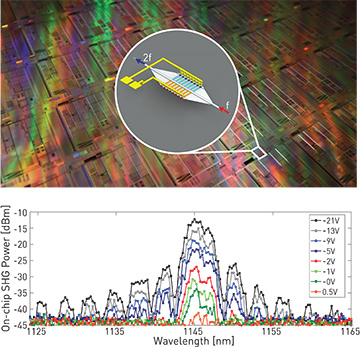 On-chip silicon second-harmonic generator (SHG, top) and SHG performance as a function of applied electric field (bottom).
On-chip silicon second-harmonic generator (SHG, top) and SHG performance as a function of applied electric field (bottom).
Having light interact at different frequencies, generate new frequencies and transfer energy from one frequency to another requires a nonlinear optical medium. Nonlinear properties in physical media originate from their crystalline arrangement. But silicon—the building block of CMOS-compatible silicon-photonics platforms—has a centrosymmetric arrangement that inhibits second-order nonlinear properties, because dipoles within silicon respond symmetrically when the light oscillates at optical frequencies.
For that reason, second-order nonlinear effects, such as second-harmonic generation, sum/difference frequency generation and pure phase modulation (that is, the DC Kerr effect), have not been not accessible in the silicon platform. These effects can be enabled, however, by adding non-CMOS compatible nonlinear elements, such as GaN, GaAs, LiNbO2,1 or strained silicon. The nonlinear processes so produced are inefficient in strained silicon, however.2 Efficient nonlinear processes require phase-matching between the interacting light frequencies—a challenging requirement, since dielectric waveguides are dispersive. For instance, the nonlinearity of periodically poled LiNbO2 (PPLN) crystals is flipped back and forward along the propagation direction of light to alleviate the lattice mismatch between materials.3
In 2017, we overcame the obstacles of these methods by exploiting the fact that silicon’s crystal symmetry can be broken when an external low-frequency or DC electric field is applied.4 In our work, an intense electric field, generated within silicon waveguides by forming compact electrical diodes, results in a large second-order nonlinear susceptibility (χ(2) = 41 pm/V).5
Using this nonlinearity, we demonstrated a high-speed, low-loss and chirp-free optical phase shifter. The device can help to realize radio frequency and microwave links with complex modulation formats without the need for signal equalization, and thus can boost data rates at data centers and in high-performance computers. Additionally, we found that the strength and position of this second-order nonlinear susceptibility could be controlled by the diode placement along the light-propagation direction, allowing for phase-matching of two different frequencies. We demonstrated second-harmonic generation (frequency doubling) of an infrared laser in a silicon waveguide, with a high conversion efficiency of 13 percent per watt.
These devices are fabricated in a CMOS foundry on 300-mm silicon-on-insulator wafers. The technique allows CMOS-compatible formation of complex, large-scale nonlinear photonic integrated circuits (PICs), such as optical parametric oscillators, terahertz generators and chirp-free modulators, without the need for adding nonlinear elements in discrete optical systems, while eliminating manual alignment requirements and reducing footprint, weight, power consumption and cost.
Researchers
Erman Timurdogan, Christopher Poulton, Matthew Byrd and Michael Watts, Massachusetts Institute of Technology, Cambridge, Mass., USA
References
1. J.S. Levy et al. Opt. Express 19, 11415 (2011).
2. M. Cazzanelli et al. Nat. Mater. 11, 148 (2012).
3. M.L. Bortz et al. IEEE J. Quant. Electron. 30, 2953 (1994).
4. P.D. Maker et al. Phys. Rev. 137, A801 (1965).
5. E. Timurdogan et al. Nat. Photon. 11, 200 (2017).
